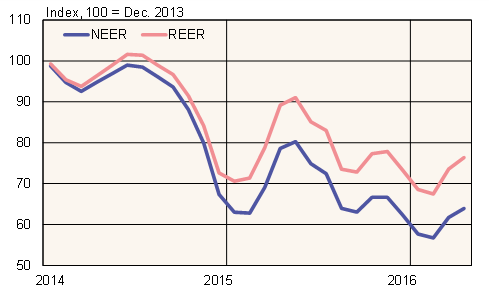BOFIT Weekly Review 24/2016
Ruble strengthening on higher oil prices
This week the ruble-dollar exchange rate hovered around 66 RUB, while the euro-ruble rate held around 74 RUB. The ruble has appreciated more than 20 % against the dollar and euro after hitting this year’s bottom in late January. Since the CBR floated the ruble in November 2014, the ruble’s exchange rate has closely tracked oil prices because the bulk of Russian forex earnings comes from oil and related exports. Depreciation pressures on the ruble have also subsided due to a sharp slowdown in capital outflows. The CBR estimated that the net outflow of private sector capital in the first five months of 2016 amounted to $13 billion, down from $50 billion in the same period in 2015.
Due to higher inflation rate in Russia than in most of its trading partners, the ruble has strengthened even more in real than nominal terms, although its value is still far below pre-collapse levels. The ruble’s real effective (trade-weighted) exchange rate in May was 22 % below end-2013.
Many Russian firms are satisfied with the ruble’s strengthening. A recent survey committed by the CBR found that over 60 % of responding firms want a stronger ruble because it would support their investment in imported machinery and equipment and reduce production costs as imported inputs would become cheaper. Firms in nearly all branches favoured ruble appreciation regardless of whether they serve the domestic market or are involved in exports.
Nominal and real effective ruble exchange rates

Sources: Central Bank of Russia, BOFIT.